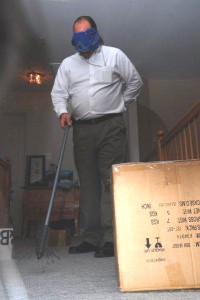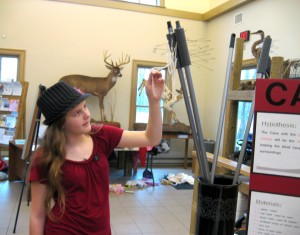by Samantha Reed
Cats don’t need their eyes to see in the dark. It turns out they have something even better. This spring, 12-year-old SERC student Samantha Reed decided to find out if the same thing could help humans.
A few years ago, my family had a blind cat named Dede. When she went blind, she could maneuver around the house with ease, bumping into things very little. I began to wonder, how could she do this? When this year’s SERC science fair came around, I thought I should do some research on cats to see how they could maneuver without sight.
I soon found that a cat’s whiskers are like a sixth sense, helping them ‘see’ as well as feel. Then it came to me: What if something that acted like a cat’s whiskers could be used to help the blind? I immediately e-mailed my science teacher at SERC, Ms. Karen [McDonald], for advice. A few days later I heard back. She was excited about my idea and gave me a few pointers. Her idea was to add ‘cat whiskers’ to the end of canes. I seized her idea and created four canes, all of the same length, with foam pieces slid onto the ends. I then took the head of a broom and cut a whole bunch of the bristles off. I cut some of them in half and stuck them into one cane, which made my short-bristled cane. The rest of the bristles where used for a second cane, which was my long-bristled cane. I used some strings from the head of a mop for a third cane, which became my long, limp bristled cane. The final cane had nothing on the end, so it was my control.

Reed's father navigates an obstacle course with the long-bristled cane. (Photo courtesy of Samantha Reed)
Of course when you do an experiment, you need victims…I mean, participants…because you can’t exactly do it all yourself. You need varied data. So I gathered my dad, three of my friends and one of my friend’s moms. After blindfolding my dad, I sent him through one of the mazes and timed how long he took to get through. Once my dad had gone through all four courses with their assigned canes, I sent my friends through in the same way: running them through the courses with a different cane for every course. During one of her runs, my friend McKenna remarked, “It’s a little scary, being blindfolded”–and it doesn’t help when you know you’re walking on a high balcony.

Reed examines the threads of the limp-bristled cane, made from mop hairs. That cane and the short-bristled cane worked best as "whiskers" for the blind, though she's still not certain why. (SERC)



Nice work Samantha! I’m surprised the limp-bristled cane was so successful. Way to use that scientific method to answer your question!
Thanks! i’m not quite sure why the limp bristled cane worked so effectively, but i think it was because my testers got a bit more confidant with being “blind” and navigating the obstacle courses.
Awesome, Samantha! Outstanding work and loved that you involved your dear ‘ole dad as a victim/participant!!
Really creative project. Seems like it took a lot of planning and work to create all those courses and walking canes. Keep thinking outside the box! – no pun intended.